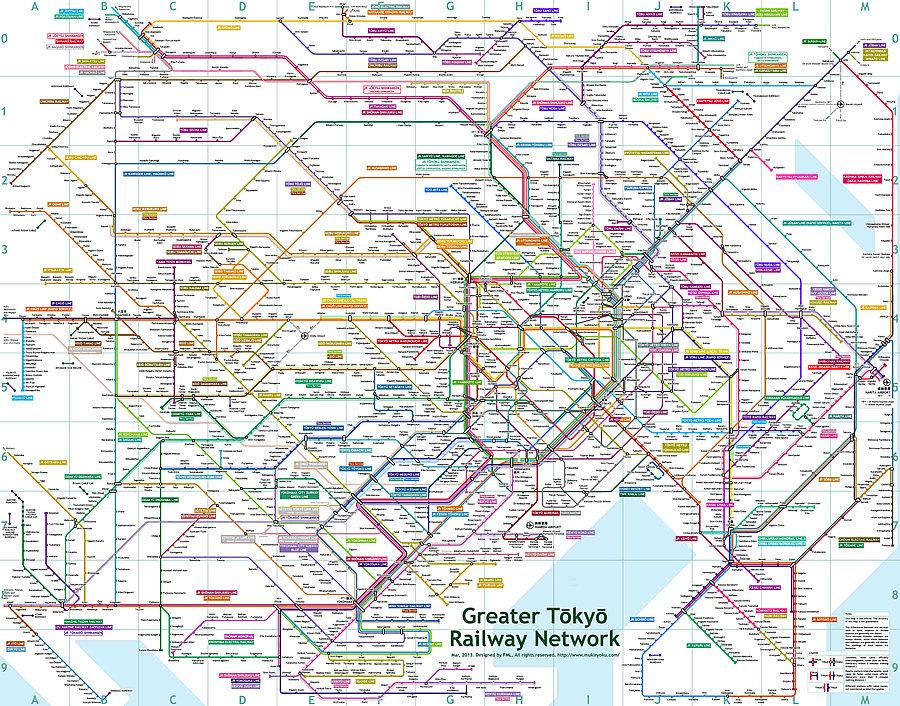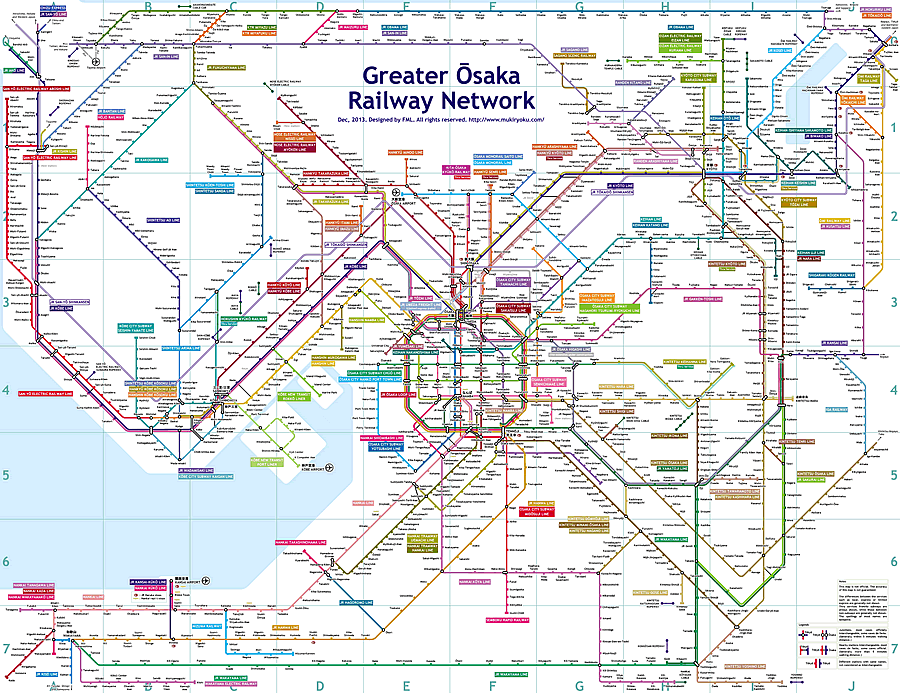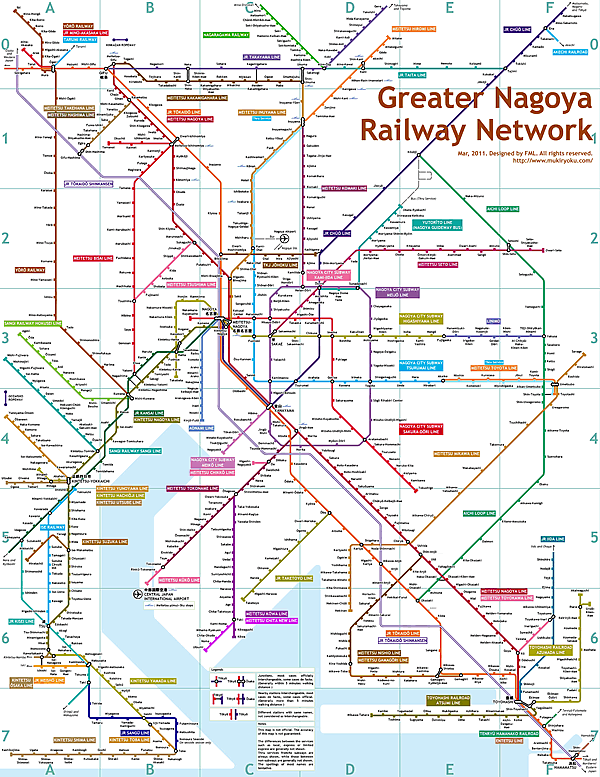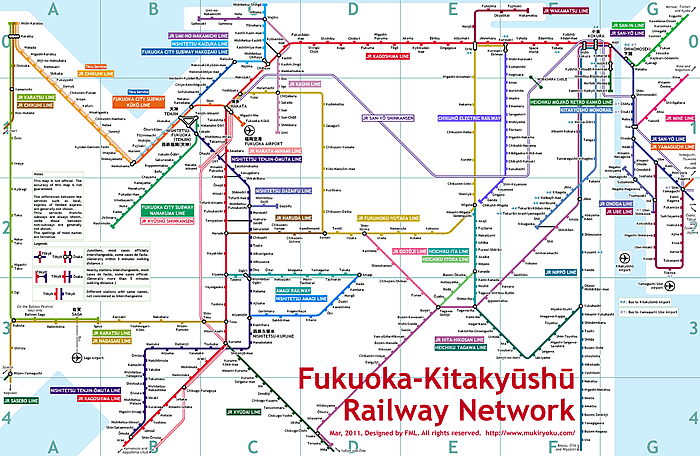Japanese Trains
Brief Overview of Japanese Trains

Railway Covers Every Corner of Japan
An extensive and reliable network of railways covers Japan’s four major islands, Honshu, Hokkaido, Kyushu and Shikoku.
In Japan, about 27,268 km of railway crisscross the nation. JR (former Japan Natinal Railway) is controlling more than 20,000km of the railway, and the other railway companies control the remaining 7,133km. In addition, some elements of railways including technologies, on-time operation rate, and service quality for passengers have reached the highest level in the world.
The Most Developed and Punctual Train System
While Germany has over 40,000km of railways but carries only about 2 billion passengers per year, Japanese railway carries more than 21 billion passengers per year. Since Japan is relatively a very dense country and railways have a significant role as a means of in-city and inter-city transportation, today's passenger transportation volume of railways in Japan accounts for 40% of the world total in market share as of 2012. Because of the massive use of its railway system, Japan is home to 46 of the world's 50 busiest stations. On the other hand, Japanese train is famous for its punctuality. Sometimes, only one minute behind of the schedule is recognized as a serious problem, because some trains run every minute.

The Pioneer and The Leader of the "Bullet Train"
Japan is the pioneer of modern high speed rail line. Shinkansen (known also as the "Bullet Train") was the first train that has exceeded the speed of 200km/h in 1964. This success made the breakthrough of the development in modern railway transportation. Now, Shinkansen (Bullet Train) links main Japanese cities at speed of up to 320km/h, and there is the plan of new Shinkansen to exceed the speed of 500km/h by using Liner Motor car technology. In addition, Japanese Bullet Trains have been operated without any fatal accident for more than 50 years. This shows the "Japanese Quality" in a safety of train operation.
Go to "Shinkansen of Japan"
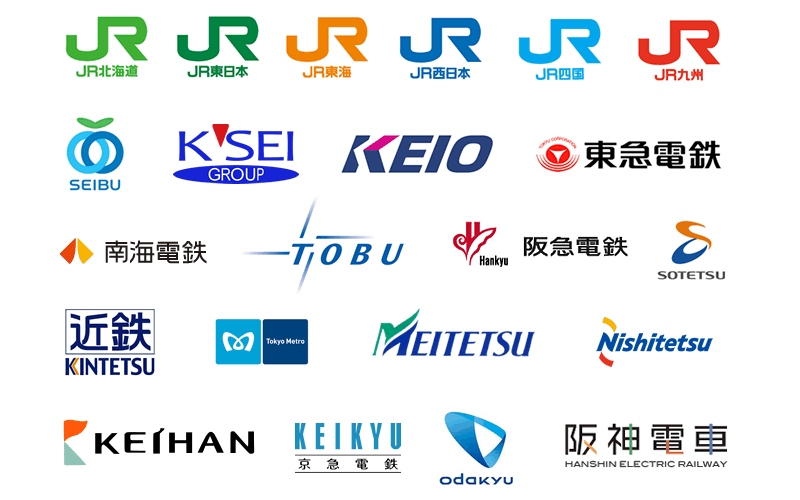
Documentary of Japanese Railway (26:45)
Characteristics of Railway in Japan
 Accuracy
Accuracy
It is said that railways in Japan are highly reliable compared with railways in other nations. Shunzo MIYAWAKI, a railway travel writer, points out the large number of in-service trains and their accuracy is what Japanese railways are proud of in today's world. In fact, there is a great story about some foreign railway officials who visited Japan; they got a pocket watch from the Japanese station attendants and checked the arrival time of a train, and when they saw the train arrived at the station on time punctual to a second, they said 'Crazy!' Incidentally, there are some documents introducing Japanese people's sense of time, in which while most overseas railways regard a delay of 5 to 15 minutes as punctual (even for high-speed railways), a delay or early arrival of 15 to 30 seconds is regarded as not punctual.
The Large Number of In-Service Trains:
In Japan, a heavily populated country, the number of in-service trains naturally tends to be more, but, at the same time, a slight time lag of a train may affect other connecting trains; therefore, maintaining punctuality has been inevitable.
Complexity of the Railway Network:
Japan is one of the countries that has the best thought-out railway network in the world, if not as good as some countries like Switzerland. Trains are often connected to each other at a junction station and sometimes make connections and separations. In this case too, a slight time lag of a train may cause a larger time lag of other connecting trains, and thus high punctuality is needed.
Human Capacity:
Many employees and workers are working hard to support the accurate train schedules, and thus addressing the problem locally even for disruptions in the time schedule. Railways in Japan could never have maintained punctuality without their ingenious attempts and efforts. Many relevant people such as Koki YUKI, a person called 'the god of train operation,' worked hard to maintain the punctuality of railways in Japan, resulting in the maintenance of today's excellent punctuality.
Large Passenger Transportation Volume The passenger transportation volume of railways in Japan is high level, especially commuter trains operated on the major lines in the Tokyo area and Osaka area, and Tokaido Shinkansen connecting major cities has high transport density unlike any other railways in the world. In the Tokyo area, the Yamanote Line, the Chuo Line, and some other lines carry 3000 to 4000 passengers at a time with 11 cars in a two minutes interval, and each major line all together carries around 120,000 passengers for an hour during rush hours, and carries around 17,000,000 passengers in a day in Tokyo area alone; this cannot be seen in railways in other developed countries. The design of six-door cars in which all seats are put away during rush hours cannot be seen in any other country, and images of the cutthroat rush hours are often introduced in foreign countries. Railways in Japan are very efficient from the perspective of energy consumption and land use, and economic activities in the national capital region (Japan), which is the largest metropolitan area in the world, could not have been achieved without these railways; on the other hand, however, there are some problems from the perspective of social comfort and welfare, which has not reached drastic improvement over 100 years in the history of railways in Japan. In addition, Tokaido Shinkansen (bullet train) is operated between Tokyo and Osaka at almost the same frequency of commuter trains, with as many as ten trains operated per hour during the morning and evening rush hours; mid- and long-distance bullet trains connecting large cities with this passenger transportation volume and frequency cannot be seen so far anywhere in the world.
The passenger transportation volume of railways in Japan is high level, especially commuter trains operated on the major lines in the Tokyo area and Osaka area, and Tokaido Shinkansen connecting major cities has high transport density unlike any other railways in the world. In the Tokyo area, the Yamanote Line, the Chuo Line, and some other lines carry 3000 to 4000 passengers at a time with 11 cars in a two minutes interval, and each major line all together carries around 120,000 passengers for an hour during rush hours, and carries around 17,000,000 passengers in a day in Tokyo area alone; this cannot be seen in railways in other developed countries. The design of six-door cars in which all seats are put away during rush hours cannot be seen in any other country, and images of the cutthroat rush hours are often introduced in foreign countries. Railways in Japan are very efficient from the perspective of energy consumption and land use, and economic activities in the national capital region (Japan), which is the largest metropolitan area in the world, could not have been achieved without these railways; on the other hand, however, there are some problems from the perspective of social comfort and welfare, which has not reached drastic improvement over 100 years in the history of railways in Japan. In addition, Tokaido Shinkansen (bullet train) is operated between Tokyo and Osaka at almost the same frequency of commuter trains, with as many as ten trains operated per hour during the morning and evening rush hours; mid- and long-distance bullet trains connecting large cities with this passenger transportation volume and frequency cannot be seen so far anywhere in the world.
 High Passenger Share in Japanese Transportation
High Passenger Share in Japanese Transportation
The share of passenger transportation of railways in Japan once dropped drastically through widespread of automobiles (motorization) from 1955 to 1974 but has still maintained about 30%, which is the highest level in the world. As mentioned earlier, trains operating in the Tokyo and Osaka areas, and the Shinkansen are relatively more convenient than other means of transportation and thus are used and are popular on a daily basis. However, unlike in the Tokyo and Osaka areas, automobiles are more convenient than railways in local areas and there are many cases where railways are not used very frequently.
Strength of Private Sector In Japan, private railways take an important role especially in the Tokyo area, Osaka area, and Nagoya area. Similarly, after privatization, East Japan Railway Company (JR East), Central Japan Railway Company (JR Central), and West Japan Railway Company (JR West) in the JR Group have been remaining in the black. These JR companies and private railway companies are developing various businesses related to lives of the railway customers and residents living along the lines such as real estate business, retail business, hotel business, and other business, while attending hard to railway business. In other countries, it is said that it is extremely difficult to turn a profit with the railway business, and thus, the railway business cannot work out without the investments of the government or other organizations. While there are many countries in which the railway network was developed by private companies in pioneer days of railways, there are no countries in which private railways have maintained the railway network widely up to the present date except for Japan. Moreover, there are also no cases where railway companies are developing various related businesses.
In Japan, private railways take an important role especially in the Tokyo area, Osaka area, and Nagoya area. Similarly, after privatization, East Japan Railway Company (JR East), Central Japan Railway Company (JR Central), and West Japan Railway Company (JR West) in the JR Group have been remaining in the black. These JR companies and private railway companies are developing various businesses related to lives of the railway customers and residents living along the lines such as real estate business, retail business, hotel business, and other business, while attending hard to railway business. In other countries, it is said that it is extremely difficult to turn a profit with the railway business, and thus, the railway business cannot work out without the investments of the government or other organizations. While there are many countries in which the railway network was developed by private companies in pioneer days of railways, there are no countries in which private railways have maintained the railway network widely up to the present date except for Japan. Moreover, there are also no cases where railway companies are developing various related businesses.
 Railways and Urban Development
Railways and Urban Development
In Japan, cities grow around the railway station, which is the center of people's lives and business and adds sparkle to people's lives, especially in the Tokyo area, Osaka area, and major terminal stations in local areas such as prefectural capitals and stops for Shinkansen. Furthermore, Tokyu Corporation, Hankyu Corporation, and some other companies have been implementing real-estate development by themselves to create suburban residential areas using their own lines as a core. Currently, throughout the world, there are not very many cases where railway stations are functioning as a center of the town or a representative of the town as especially seen in the Tokyo area and Osaka area in Japan.
Well-Maintained Public Peace and High Standards of Cleanliness Japan is one of the countries where railways have the best-maintained public peace and highest standards of cleanliness in the world. Some people point out the deterioration of public security, but even if someone falls asleep on a subway in Japan, he/she is unlikely to stumble into crime, and even at night, a woman can take a train alone in peace, which is worthy of special mention from a world perspective. In addition, while there are quite a few countries in which graffiti on the trains and trains with damages to property (vandalism) can be seen, these cases are very rare in Japan and railway cars are generally respected as a public property and thus kept clean.
Japan is one of the countries where railways have the best-maintained public peace and highest standards of cleanliness in the world. Some people point out the deterioration of public security, but even if someone falls asleep on a subway in Japan, he/she is unlikely to stumble into crime, and even at night, a woman can take a train alone in peace, which is worthy of special mention from a world perspective. In addition, while there are quite a few countries in which graffiti on the trains and trains with damages to property (vandalism) can be seen, these cases are very rare in Japan and railway cars are generally respected as a public property and thus kept clean.



Railway Network Map of Japan
Introduction of Representative Special Express
Emperor's Royal Train

JR Narita Express (NEX)

KEISEI Skyliner

JR Super Kamui

JR 485 series

JR E751 series

JR Inaho Express

JR E653 series

JR Cassiopeia Express

TOBU Specia Express

TOBU New Express

ODAKYU Romancecar VSE

ODAKYU Romancecar MSE

ODAKYU Romancecar EXE

JR 287 series

JR Boso View Express

JR Shinano Express

JR Twilight Express

JR Super View Express

JR E353

JR Nikko Express

JR Sunrise Express

JR Super Hitachi Express

JR Hakutaka Express

JR Shirasagi Express

Hakone Mountain Express

MEITETSU Mu sky

SAGANO Express

JR Ocean Arrow Express

JR Haruka Express

KINTETSU Ise-Shima Liner

KINTETSU Urban Liner Next

KINTETSU Urban Liner Plus

KINTETSU 22600 series

KINTETSU Sakura Liner

KINTETSU Shimakaze Express

KINTETSU Raku Express

JR KTR001 series

JR KTR8000 series

NANKAI Rapit

JR Thunderbird Express

EIZAN Japanese Maple Express

JR Shiokaze Express

JR Ishizuchi Express

JR Seven Stars Express

JR Yufuin no Mori Express

JR Sonic Express

JR Kamome Express

JR Shikijima Express

JR West Tourism Express

Disney Resort Line

Introduction of Representative Commuter Rail
JR 733 series

SAPPORO Railway

SAPPORO METRO

JR Senseki Line

SENDAI METRO

JR New Yamanote Line

JR Yamanote Line

JR Takasaki Line

JR Chuon Line

JR Keihin-Tohoku Line

JR Joban Line Metro version

JR Shonan-Sinjuku Line

JR Keiyo Line

JR Yokohama Line

JR Saikyo Line

JR Somu Line

JR Joban Line

JR Chuo Line Metro version

JR Yokosuka Line

JR Nambu Line

JR Joban Line

JR Nikko Line

JR Narita Line

JR Utsunomiya Line

JR kururi Line

JR Musashino Line

SEIBU 30000 series

SEIBU 20000 series

SEIBU 10000 series

SEIBU 9000 series

SEIBU 6000 series

TOBU 50000 series

TOBU 60000 series

TOKYO METRO Ginza Line

TOKYO METRO Marunouchi Line

TOKYO METRO Hibiya Line

TOKYO METRO Tozai Line

TOKYO METRO Chiyoda Line

TOKYO METRO Fuku-Toshin Line

TOKYO METRO Hanzomon Line

TOKYO METRO Namboku Line

TOEI Arakawa Line

TOEI Arakawa Line (retro)

TOEI Asakusa Line

TOEI Mita Line

TOEI Shinjuku Line

TOEI Oedo Line

TOKYU 5000 series

TOKYU 6000 series

TOKYU 7000 series

KEISEI 3700 series

KEISEI 3400 series

KEIO 9000 series

KEIO 1000 series

KEIO 8000 series

KEIKYU 2100 series

KEIKYU 1000 series

ODAKYU 4000 series

ODAKYU 3000 series

Chiba City Mono-rail

Yokohama Minatomirai Line

SAGAMI 11000 series

SAGAMI 10000 series

Yokohama Seaside Line

Tama City Mono-rail

Shonan City Mono-rail

Yurikamome

TX Tsukuba express

Tokyo Mono-rail

Saitama New Shuttle

Tokyo Waterfront Rapid Line

Enoshima Railway

MEITETSU 300 series

MEITETSU 1380 series

MEITETSU 1700 series

MEITETSU 3300 series

MEITETSU 4000 series

MEITETSU 5000 series

Nagoya Subway 7000 series

Nagoya Subway 6050 series

Nagoya Subway N1000 series

Nagoya Aonami Line

Linimo Line

JR Tokaido Line

JR Kosai Line

JR Hokuriku Line

JR Kohama Line

JR Sanyo Line

JR Marine Liner

JR Kyoto Line

JR Kobe Line

JR Hiroshima Line

Toyama Centram

Toyama Portram

Manyo Line

Fukui Railway

KEIHAN 13000 series

KEIHAN 10000 series

KEIHAN 8000 series

KINTETSU 16000 series

KINTETSU 22000 series

HANSHIN 9300 series

HANSHIN 9000 series

HANSHIN 8000 series

HANSHIN 5500 series

HANSHIN 1000 series

HANSHIN 5700 series

HANKYU 9300 series

HANKYU 8300 series

HANKYU 7300 series

HANKYU 1000 series

NANKAI 12000 series

NANKAI 8000 series

SENBOKU 7020 series

SANYO 5000 series

OSAKA METRO 200 series

OSAKA METRO 30000 series

OSAKA 9000 series

KOBE Rokko Liner

KOBE Port Liner

KOBE 6000 series

OKAYAMA Railway

HIROSHIMA Railway

HIRODEN 1000 series

IYODEN 2100 series

Kitakyusyu Mono-rail

NISHITETSU 3000 series

Fukuoka City Subway 3000 series

JR Chikuhi Line

JR Kagoshima Line

JR Nippo Line

Kumamoto Railway

Kagoshima Utram

Nagasaki Tramway

Okinawa Yuirail

Gallery of Steam Locomotive Express
SL Galaxy Express

SL Paleo Express

SL Oigawa C56 Express

SL Oigawa Thomas Express

SL Yamaguchi Express

SL Aizu Tadami Express

SL Mooka Express

SL Usui Express

SL Minakami Express

SL Shonai Express

SL Shinanogawa Express

SL Banetsu Express

SL SendaiMiyagi Express

SL Niseko Express

SL Tokachi Express

SL HakodateOnuma Express

SL Furano Express

SL Okhotsk Express

SL Kushiro Express


